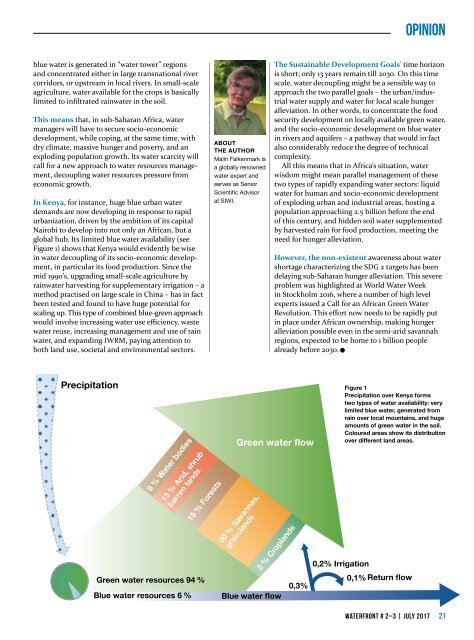Stockholm Water Front no 2-3 2017
Create successful ePaper yourself
Turn your PDF publications into a flip-book with our unique Google optimized e-Paper software.
opinion<br />
blue water is generated in “water tower” regions<br />
and concentrated either in large transnational river<br />
corridors, or upstream in local rivers. In small-scale<br />
agriculture, water available for the crops is basically<br />
limited to infiltrated rainwater in the soil.<br />
This means that, in sub-Saharan Africa, water<br />
managers will have to secure socio-eco<strong>no</strong>mic<br />
develop ment, while coping, at the same time, with<br />
dry climate, massive hunger and poverty, and an<br />
exploding popula tion growth. Its water scarcity will<br />
call for a new approach to water resources management,<br />
decoupling water resources pressure from<br />
eco<strong>no</strong>mic growth.<br />
In Kenya, for instance, huge blue urban water<br />
demands are <strong>no</strong>w developing in response to rapid<br />
urbanization, driven by the ambition of its capital<br />
Nairobi to develop into <strong>no</strong>t only an African, but a<br />
global hub. Its limited blue water availability (see<br />
Figure 1) shows that Kenya would evidently be wise<br />
in water decoupling of its socio- eco<strong>no</strong>mic development,<br />
in particular its food production. Since the<br />
mid 1990’s, upgrading small-scale agriculture by<br />
rainwater harvesting for supplementary irrigation – a<br />
method practised on large scale in China – has in fact<br />
been tested and found to have huge potential for<br />
scaling up. This type of combined blue-green approach<br />
would involve increasing water use efficiency, waste<br />
water reuse, increasing management and use of rain<br />
water, and expanding IWRM, paying attention to<br />
both land use, societal and environmental sectors.<br />
ABOUT<br />
THE AUTHOR<br />
Malin Falkenmark is<br />
a globally re<strong>no</strong>wned<br />
water expert and<br />
serves as Senior<br />
Scientific Advisor<br />
at SIWI.<br />
The Sustainable Development Goals’ time horizon<br />
is short; only 13 years remain till 2030. On this time<br />
scale, water decoupling might be a sensible way to<br />
approach the two parallel goals – the urban/industrial<br />
water supply and water for local scale hunger<br />
alleviation. In other words, to concentrate the food<br />
security development on locally available green water,<br />
and the socio-eco<strong>no</strong>mic development on blue water<br />
in rivers and aquifers – a pathway that would in fact<br />
also considerably reduce the degree of technical<br />
complexity.<br />
All this means that in Africa’s situation, water<br />
wisdom might mean parallel management of these<br />
two types of rapidly expanding water sectors: liquid<br />
water for human and socio-eco<strong>no</strong>mic development<br />
of exploding urban and industrial areas, hosting a<br />
population approaching 2.5 billion before the end<br />
of this century, and hidden soil water supplemented<br />
by harvested rain for food production, meeting the<br />
need for hunger alleviation.<br />
However, the <strong>no</strong>n-existent awareness about water<br />
shortage characterizing the SDG 2 targets has been<br />
delaying sub-Saharan hunger alleviation. This severe<br />
problem was highlighted at World <strong>Water</strong> Week<br />
in <strong>Stockholm</strong> 2016, where a number of high level<br />
experts issued a Call for an African Green <strong>Water</strong><br />
Revolution. This effort <strong>no</strong>w needs to be rapidly put<br />
in place under African ownership, making hunger<br />
alleviation possible even in the semi-arid savannah<br />
regions, expected to be home to 1 billion people<br />
already before 2030.<br />
Precipitation<br />
9 % <strong>Water</strong> bodies<br />
13 % Arid, shrub<br />
barren lands<br />
Green water resources 94 %<br />
Blue water resources 6 %<br />
15 % Forests<br />
Green water flow<br />
50 % Savannas,<br />
grasslands<br />
8 % Croplands<br />
Blue water flow<br />
Figure 1<br />
Precipitation over Kenya forms<br />
two types of water availability: very<br />
limited blue water, generated from<br />
rain over local mountains, and huge<br />
amounts of green water in the soil.<br />
Coloured areas show its distribution<br />
over different land areas.<br />
0,2% Irrigation<br />
0,1% Return flow<br />
0,3%<br />
WATERFRONT # 2–3 | JULY <strong>2017</strong><br />
21


















